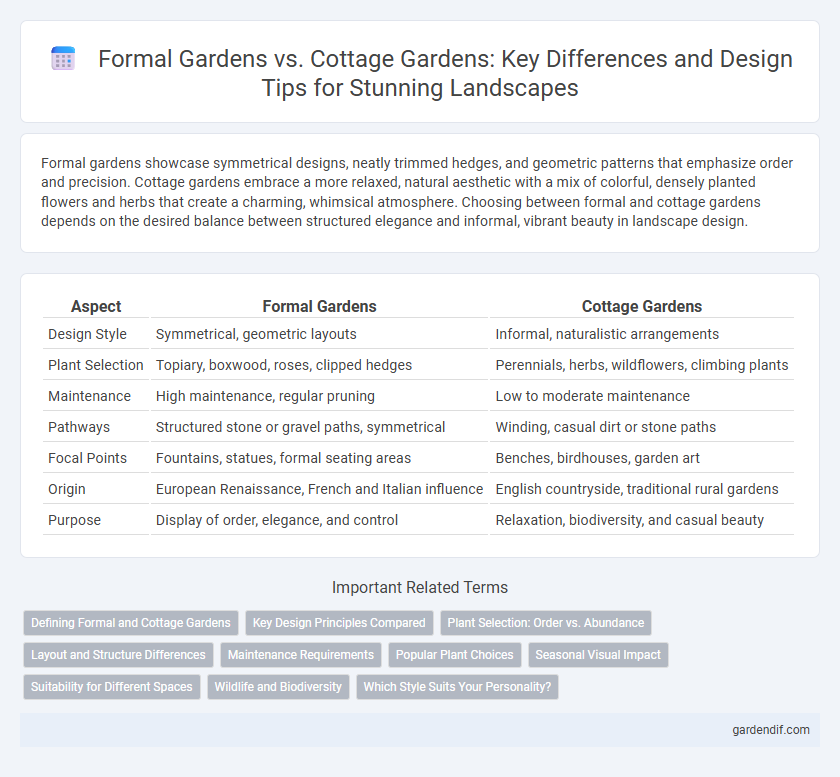
Formal Gardens vs Cottage Gardens Illustration
Formal gardens showcase symmetrical designs, neatly trimmed hedges, and geometric patterns that emphasize order and precision. Cottage gardens embrace a more relaxed, natural aesthetic with a mix of colorful, densely planted flowers and herbs that create a charming, whimsical atmosphere. Choosing between formal and cottage gardens depends on the desired balance between structured elegance and informal, vibrant beauty in landscape design.
Table of Comparison
| Aspect | Formal Gardens | Cottage Gardens |
|---|---|---|
| Design Style | Symmetrical, geometric layouts | Informal, naturalistic arrangements |
| Plant Selection | Topiary, boxwood, roses, clipped hedges | Perennials, herbs, wildflowers, climbing plants |
| Maintenance | High maintenance, regular pruning | Low to moderate maintenance |
| Pathways | Structured stone or gravel paths, symmetrical | Winding, casual dirt or stone paths |
| Focal Points | Fountains, statues, formal seating areas | Benches, birdhouses, garden art |
| Origin | European Renaissance, French and Italian influence | English countryside, traditional rural gardens |
| Purpose | Display of order, elegance, and control | Relaxation, biodiversity, and casual beauty |
Defining Formal and Cottage Gardens
Formal gardens feature symmetrical layouts, geometric shapes, and meticulously trimmed hedges, creating an orderly and structured appearance. Cottage gardens emphasize a natural, informal design with a diverse mix of flowering plants, herbs, and shrubs growing in a seemingly spontaneous arrangement. The contrast lies in formal gardens' precision and control versus cottage gardens' relaxed, whimsical charm.
Key Design Principles Compared
Formal gardens emphasize symmetry, geometric shapes, and carefully manicured hedges to create a structured, orderly appearance. Cottage gardens prioritize informal layouts, dense plantings, and a mix of flowers and herbs for a natural, whimsical charm. Key design principles differ in plant selection, layout precision, and maintenance intensity, with formal gardens requiring meticulous upkeep and cottage gardens allowing for more organic growth.
Plant Selection: Order vs. Abundance
Formal gardens prioritize plant selection based on symmetry and order, often featuring neatly trimmed hedges, topiary, and a limited palette of species arranged in geometric patterns. Cottage gardens emphasize abundance and diversity, showcasing a mix of perennials, annuals, and herbs that create a lush, informal, and naturalistic appearance. The contrast in plant selection highlights the structured precision of formal gardens versus the vibrant, overflowing texture of cottage gardens.
Layout and Structure Differences
Formal gardens feature symmetrical layouts, geometric shapes, and defined pathways, emphasizing order and precision through neatly trimmed hedges and structured plantings. Cottage gardens embrace irregular, free-flowing designs with mixed plant varieties, prioritizing a natural, informal aesthetic rich in color and texture. The structured symmetry of formal gardens contrasts sharply with the organic, relaxed arrangement typical of cottage gardens.
Maintenance Requirements
Formal gardens require meticulous maintenance, including regular pruning, precise trimming of hedges, and consistent weeding to maintain their structured appearance. Cottage gardens involve less rigid upkeep, favoring natural growth with periodic pruning and deadheading to encourage flowering and control overgrowth. The maintenance intensity of formal gardens often demands more time and expertise compared to the more relaxed, adaptive care suitable for cottage gardens.
Popular Plant Choices
Formal gardens often feature symmetrical layouts with popular plant choices such as boxwood, yew, and lavender, which provide structure and evergreen appeal. Cottage gardens embrace a more relaxed, naturalistic style, favoring plants like roses, hollyhocks, foxgloves, and daisies that create a colorful, informal atmosphere. Both garden types utilize perennials and herbs, but their plant selections reflect distinct design philosophies emphasizing precision versus charm.
Seasonal Visual Impact
Formal gardens emphasize structured layouts with manicured hedges and symmetrical flower beds, providing consistent visual appeal throughout the year. Cottage gardens showcase a diverse mix of flowering plants and herbs that bloom at different times, creating a dynamic and ever-changing seasonal display. Seasonal visual impact in formal gardens relies on shape and evergreen elements, while cottage gardens depend on the vibrant succession of blooms and foliage colors.
Suitability for Different Spaces
Formal gardens excel in structured, spacious areas where geometric designs and symmetry can be fully appreciated, making them ideal for large estates or public parks. Cottage gardens are better suited for smaller, informal spaces, offering a relaxed charm with dense plantings of flowers, herbs, and vegetables that thrive in compact environments. Selecting between the two depends on the size, purpose, and desired aesthetic of the landscape area.
Wildlife and Biodiversity
Formal gardens often feature structured layouts and manicured plants, limiting habitat variety and thus supporting fewer wildlife species. Cottage gardens embrace diverse native plants and layered planting, creating rich habitats that enhance local biodiversity by attracting pollinators, birds, and beneficial insects. Integrating native species in cottage gardens fosters ecological balance, making them preferable for wildlife conservation compared to the more ornamental focus of formal gardens.
Which Style Suits Your Personality?
Formal gardens showcase symmetry, neatly trimmed hedges, and geometric patterns that appeal to those who appreciate order and precision in their surroundings. Cottage gardens feature a relaxed, whimsical mix of flowering plants and herbs, ideal for individuals who enjoy a natural, cozy, and colorful outdoor space. Choosing between formal and cottage gardens depends on whether you prefer structured elegance or an informal, vibrant atmosphere reflecting your personality.
Formal Gardens vs Cottage Gardens Infographic

 gardendif.com
gardendif.com